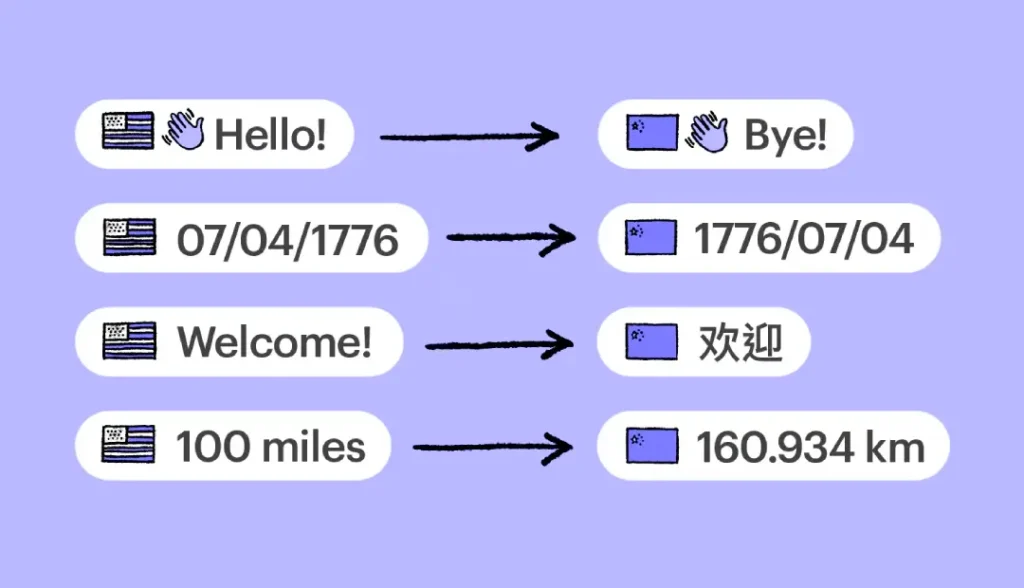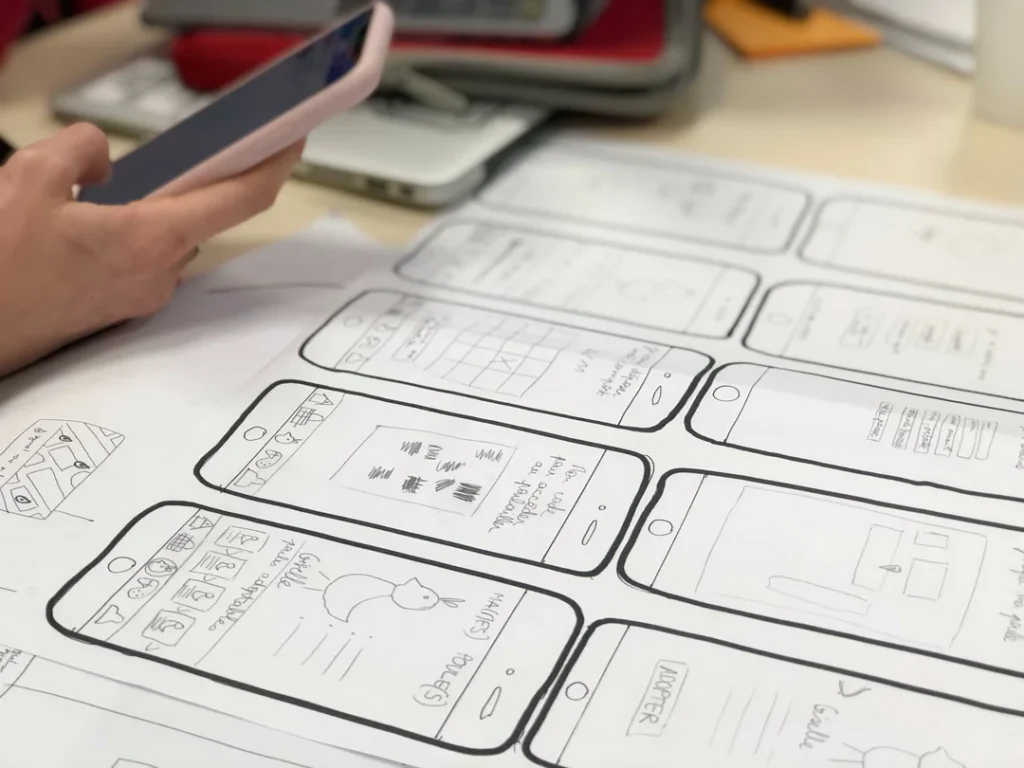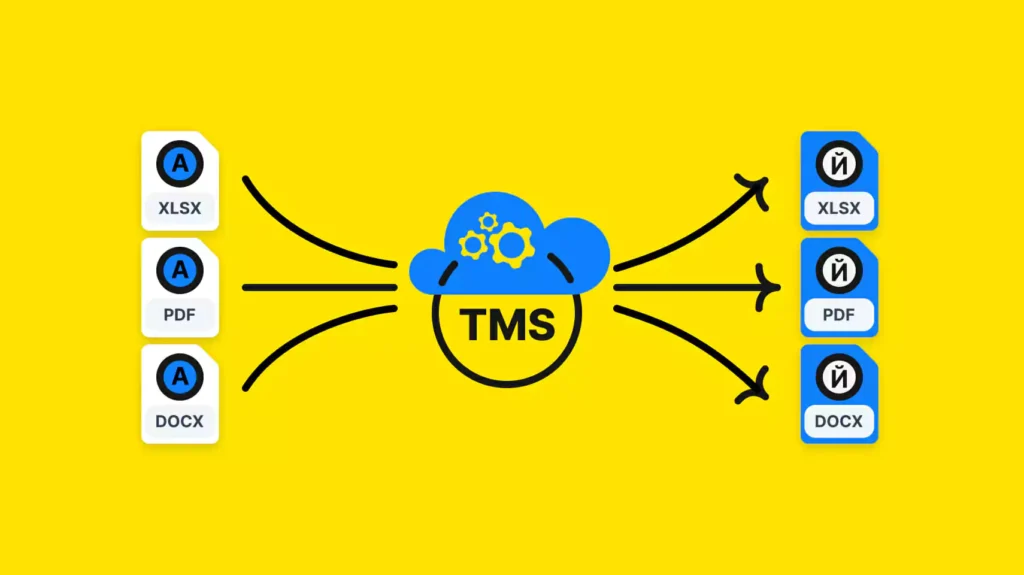UX Localisation: Creating Digital Experiences That Transcend Borders
UX localisation, the secret weapon of international success, tailors your product to each culture, transforming clicks into connections and messages into universal understanding. Adopt the power of localisation to sharpen your cultural compass, and get ready to conquer the world with design savvy that speaks volumes, no matter the language.
While UX localisation unlocks a world of potential, a single misstep can leave your meticulously crafted experience lost in translation. A staggering 88% of online consumers turn tail after a bad experience, and cultural faux pas translate directly to digital disaster. Learn how to navigate the cultural landscape, ensure your UX transcends borders, and leave only captivated users in its wake.
Table of Contents
Understanding UX Localisation

UX localisation is the strategic process of adapting a user experience (UX) to resonate with diverse audiences across different cultures, languages, and regions. The key objectives of UX localisation are as follows:
- Increase user engagement and satisfaction: By understanding and catering to local preferences, you can create experiences that resonate deeply with users.
- Improve brand perception: Demonstrating cultural sensitivity and inclusivity can build trust and loyalty among global audiences.
- Boost market share and ROI: Expanding your reach to new markets can unlock significant growth opportunities.
The Importance of Tailoring the User Experience for Different Cultures
Forget the “one size fits all” approach. In the realm of UX, cultural sensitivity reigns supreme. Consider this: 70% of global consumers feel loyal to websites that cater to their language preferences. Ignoring these nuances can confuse and frustrate users and trigger a digital exodus.
The Benefits of UX Localisation for a Global Audience
Localised UX is not only a nice thing to do. It is a strategic investment with real-world returns:
- Conversions and revenue boost: Studies show localised experiences can increase conversion rates by 20%.
- Reach expansion: Localised UX opens doors to 73% of the global population who prefer to access information in their native language.
- Enhances brand perception: Culturally relevant UX showcases your commitment to understanding and respecting your audience, fostering brand trust and positive perception.
- Improves SEO performance: Search engines favour localised content, optimising your site for higher visibility in international markets.
- Minimises legal risks: Avoiding cultural faux pas in your UX can prevent legal repercussions stemming from misunderstandings.
- Reduces support costs: Localised UIs minimise user confusion and support requests, resulting in cost savings.
- Increases user engagement: Culturally relevant content resonates deeper, leading to longer dwell times and higher engagement metrics.
- Strengthens competitive advantage: Stand out from the crowd by offering a tailored, culturally aware experience that competitors might lack.
- Unlocks brand advocacy: Happy, engaged users become brand advocates, promoting your product organically within their communities.
- Future-proofs your growth: Investing in UX localisation sets you for sustainable, scalable growth in a globalised market.
Factors to Consider in UX Localisation

Crafting a world-beating UX experience requires navigating the nuances of different cultures. It may remind you of the process of deciphering a treasure map for hidden user engagement. Here are the key factors to consider for successful UX localisation:
#1. Language Translation and Adaptation
The translation might seem straightforward. It, however, is not only about swapping words:
- Localisation vs. direct translation: Avoid falling into the “copy-paste” trap. Words may have various meanings across markets. Localisation adapts the message to resonate with local audiences. For example, “chips” (UK) and “fries” (US).
- Dialect and slang: Avoid regional slang that might confuse users in other parts of the country. Opt for clear, neutral language.
- Cultural references: Jokes or idioms might need to be revised in translation. Choose universally understood references or adapt them for a local touch.
#2. Cultural Sensitivity and Appropriateness
In UX localisation, you must respect local customs and avoid cultural blunders. It includes:
- Cultural norms research: Understanding greetings, colours, symbols, and religious sensitivities is crucial. For example, the thumbs-up gesture should be avoided in certain cultures.
- Avoiding stereotypes: Avoid relying on clichés or outdated portrayals of different cultures.
- Conducting local testing: Get feedback from native speakers to ensure your message lands as intended.
#3. Design and Visual Elements
Images and design speak volumes. Thus, it is your responsibility to ensure they are culturally appropriate:
- Colours and symbolism: Pay attention to colour associations in different cultures. For example, red might symbolise good luck in China but danger in some European countries.
- Imagery and icons: Avoid using offensive or culturally insensitive images. Opt for inclusive and universally understood visuals.
- Fonts and layouts: Consider different reading habits and character sets across languages. Right-to-left reading needs proper formatting.
#4. Navigation and User Flow
Ensure your users can find their way around, regardless of their native language. Here is how:
- Intuitive navigation: Simplify navigation menus and icons with clear visuals and consistent placement.
- Local search functionality: Enable search using local keywords and language features.
- Accessibility: Ensure your UX caters to users with disabilities, adhering to local accessibility standards.
#5. Legal and Regulatory Compliance
When localising your data, be mindful of local laws and regulations that might impact your UX:
- Data privacy: Understand and comply with data protection regulations like GDPR or CCPA.
- Age restrictions: Adhere to age-gating requirements for specific content or functionalities.
- Intellectual property: Ensure you have the right to use any images, trademarks, or other copyrighted material in different jurisdictions.
The Best Practices for Successful UX Localisation

Building a website or app that transcends borders and resonates with global audiences requires attention to UX localisation. Here is how you can ensure your web localisation efforts unlock seamless, inclusive, and engaging UX across languages and locations:
1 – Conduct User Research and Testing in Different Markets
Do not assume that what works in one market translates perfectly to another. Conduct user research specific to your target regions:
- Free/low-cost user research tools: Consider using free online surveys like Google Forms or Typeform for initial data collection. Explore usability testing platforms like UserTesting or Lookback for affordable remote testing options.
- Crowdsourcing platforms: Utilise platforms like UserTesting or UserLeap to connect with participants from specific locations and demographics.
- Localisation agencies: Partner with affordable localisation agencies that offer user research services tailored to your target markets.
2 – Collaborate with Native Speakers and Cultural Experts
Partner with native speakers who possess linguistic expertise and a deep cultural understanding of your target markets:
- Freelance marketplaces: Websites like Upwork or Fiverr can connect you with freelance translators and cultural experts with relevant expertise.
- Universities and language schools: Contact local universities or language schools to find students or faculty willing to collaborate on cultural insights.
- Online communities: Connect with communities specific to your target markets to gain cultural perspectives and feedback.
3 – Implementing Flexible Design and Content Strategies
Design with internationalisation in mind, opting for layouts that easily accommodate text expansion or contraction across languages:
- Content management systems (CMS): Choose a CMS with built-in localisation features to facilitate easy content updates and language management.
- Design system tools: Utilise tools like Figma or Adobe XD that allow for language-specific variations and easy localisation of design elements.
- Machine translation APIs: Leverage machine translation APIs for initial content localisation, followed by human refinement for accuracy and cultural nuances.
4 – Prioritise Accessibility and Inclusivity
Adhere to international accessibility standards like WCAG guidelines to ensure your web experience is usable by people with disabilities, regardless of their location:
- Utilise clear and concise language. Avoid cultural references or idioms that might not be universally understood.
- Web accessibility resources: Utilise free web accessibility tools like Lighthouse or WAVE to identify and address accessibility issues.
- Accessibility testing services: Partner with accessibility testing companies to conduct comprehensive audits and ensure compliance with international standards.
- Localisation vendors with accessibility expertise: Choose vendors that offer services specialised in accessible web development and content creation.
Tools and Technologies for Streamlining UX Localisation

Conquering the world of UX localisation does not have to be a Herculean feat. Here is your toolkit for success:
#1. Translation Management Systems (TMS)
Think of a TMS as your centralised command centre for multilingual content. It streamlines the translation process by:
- Managing translation vendors and freelancers: Assign projects, track progress, and ensure quality control across different languages.
- Leveraging translation memories and glossaries: Reuse previously translated content and ensure consistency in terminology, saving time and money.
- Automating repetitive tasks: Automate tasks like file format conversion and terminology extraction, freeing up your team for more strategic work.
Popular TMS options include:
- Centus
- Lokalise
- Memsource
- XTM Cloud
Actionable tip: Explore free trials of different TMS options to find the best fit for your needs and budget.
#2. Content Management Systems with Localisation Capabilities
Gone are the days of updating content for each language by hand. Modern CMS platforms like:
- WordPress: It integrates seamlessly with popular translation plugins like WPML and Polylang.
- Drupal: This tool offers built-in multilingual features and a vast community of localisation developers.
- Adobe Experience Manager: It provides advanced translation management tools for large-scale enterprises.
Using these platforms, you will be able to do the following:
- Manage content in different languages: Edit, publish, and schedule content updates effortlessly across languages.
- Localised URLs and metadata: Ensure search engine visibility in all your target markets.
- Utilise language-specific workflows: Control user roles and permissions for each language version.
Actionable tip: Identify your CMS's built-in localisation features and explore available plugins or integrations to enhance your capabilities.
#3. Automated Localisation Testing Tools
Manual testing across languages can be time-consuming and prone to errors. Luckily, there are tools like:
- Applitools: This digital instrument automatically detects visual and functional regressions after localisation.
- Lokalise QA: It offers automated testing for consistency and accuracy across languages.
- BrowserStack: This tool enables cross-browser and cross-device testing for different regions and languages.
These tools can help you:
- Catch UI inconsistencies and bugs to ensure a good UX design across languages.
- Verify text accuracy and cultural appropriateness to avoid embarrassing misinterpretations.
- Test accessibility compliance to guarantee your website is inclusive for all users.
Actionable tip: Start with basic free trials of these tools to test their functionalities and identify the best fit for your needs.
#4. Cultural Intelligence (CQ) Platforms
Platforms like CulturePulse leverage data and expert insights to help you understand cultural nuances and sensitivities in your target markets. They offer features like:
- Cultural risk assessments: Identify potential pitfalls and avoid unintentional offences before they happen.
- Cultural insights reports: Gain detailed information about each market's cultural values, behaviours, and preferences.
- Real-time guidance: Access on-demand advice from cultural experts during the localisation process.
Actionable tip: Explore free trials or demo versions of different CQ platforms to see which fits your needs and budget best.
#5. Crowdsourcing Platforms for Usability Testing
Here are the platforms that will allow you to recruit and conduct remote usability testing with users from specific locations and demographics:
- TestMySite: Offers a global network of testers and a variety of testing options, including localisation testing.
- UserLeap: Similar to UserTesting, you can recruit users based on specific demographics and locations.
- PlaytestCloud: Focuses on mobile app testing and offers a large pool of international testers.
- Applause: Provides a wide range of testing services, including functional testing, usability testing, and localisation testing.
- BetaPlace: Connects businesses with beta testers worldwide and offers features like targeted recruitment and in-app surveys.
- UserCrowd: Provides various testing solutions, including website testing, app testing, and localisation testing.
- TestingTime: Offers a large pool of testers from over 150 countries and supports multiple languages for localisation testing.
Actionable tip: Start with small, targeted tests to identify major usability issues in your localised versions, and then iterate based on the feedback you receive.
Real-World Examples of Effective UX Localisation

Now, you have equipped yourself with the tools, but how do the masters utilise them in the real world? Delve into inspiring examples of UX localisation done right:
Duolingo's Language-Learning Gamification
This owl-loving platform understands cultural nuances. It adjusts its mascots, humour, and references to resonate in local markets. In Japan, their mascot became a cat to tap into the kawaii culture.
Nike's Localised Slogans
Nike does not translate. They adapt their iconic “Just Do It” tagline to local contexts. In China, for example, it became “Dare to Do, Fear Nothing,” capturing the cultural spirit of perseverance.
Netflix's Multilingual Personalisation
This entertainment giant goes beyond subtitles. It personalises user recommendations and interfaces according to his language and cultural preferences.
Airbnb's Localisation for Trust
Safety is paramount for travellers. Airbnb showcases hosts and neighbourhoods with relevant details and visuals based on local customs and expectations.
Challenges in UX Localisation and How to Overcome Them
The path to UX localisation glory is always paved with mistakes. Understanding these obstacles and wielding the right tactics beforehand allows you to navigate the labyrinth victoriously.
Cultural Nuances
Navigating cultural differences is paramount, as even the slightest misstep can lead to offence and hinder your global design aspirations.
- Challenge: Humor, imagery, and even colours can have vastly different connotations across cultures. A seemingly innocent joke might land with a thud, or a vibrant colour might evoke unintended emotions.
- Expert Tip: Conduct thorough cultural research involving native speakers and experts. Utilise tools like cultural sensitivity checklists and conduct A/B testing with local user groups.
Translation Mishaps
Machine translation might offer a tempting shortcut, but you must ensure your message lands by investing in qualified human translators.
- Challenge: Direct translation often falls flat, failing to capture cultural nuances and linguistic subtleties. Machine translation, while tempting, can lead to embarrassing errors.
- Expert Tip: Invest in high-quality human translators with relevant domain expertise and cultural understanding. Consider using translation memory tools (TMT) to ensure accuracy and glossaries for terminology appropriateness. Proofread meticulously, seeking feedback from native speakers.
Content Overload
Taming the content beast across languages requires strategic planning and efficient tools. Prioritise key content, leverage modular structures, and embrace technology to conquer the multilingual minefield.
- Challenge: Expanding to multiple languages can lead to overwhelming content volumes, requiring significant maintenance and updates. Managing different versions across platforms can also become a logistical nightmare.
- Expert Tip: Implement a robust content management system with localisation capabilities. Leverage modular content structures and machine translation for initial drafts, followed by human refinement.
Design Inconsistencies
Crossing language barriers doesn't have to mean visual roadblocks.
- Challenge: Text expansion or contraction in different languages can disrupt layouts, leading to visual inconsistencies and usability issues. Ignoring local design principles can also alienate users.
- Expert Tip: Implement flexible design systems that adapt to different character lengths. Avoid the “squint-to-see” syndrome for global users! Embrace responsive design – the secret sauce for ensuring your design effortlessly adapts to other devices and languages, like a linguistic chameleon for the digital age—and partner with local designers to understand regional design preferences and cultural sensitivities.
Accessibility Hurdles
Prioritise inclusivity from the start. Adhere to international standards, utilise assistive technology testing, and involve users with disabilities to ensure your design transcends language barriers and embraces everyone.
- Challenge: Accessibility standards vary across regions, and neglecting them can exclude users with disabilities from your target markets.
- Expert Tip: Conduct accessibility audits for each localised version, adhering to international standards like WCAG. Utilise assistive technology testing tools and involve users with disabilities in testing. Prioritise inclusivity from the design stage to create truly barrier-free experiences.
Technical Complexities
Streamline workflows, automate repetitive tasks, and prioritise continuous testing to conquer technical hurdles and ensure smooth performance across all language versions.
- Challenge: Integrating translation workflows with existing development processes can be challenging. Managing multilingual updates can be a technical tightrope walk. One misstep and you are left with a spaghetti code nightmare.
- Expert Tip: Utilise translation management systems and CMS integrations to streamline workflows. Automate repetitive tasks like file format conversion and terminology extraction. Invest in testing to keep your site error-free across all languages.
Budget Constraints
Prioritise key markets, leverage technology strategically and explore partnerships to maximise ROI and overcome financial hurdles in your global design quest.
- Challenge: Localisation can be expensive, especially when targeting multiple languages. Balancing cost-efficiency with quality can be a tricky negotiation.
- Expert Tip: Prioritise key markets and languages based on potential return on investment—Utilise machine translation for initial drafts, followed by human refinement for critical content.
Time Pressures
Do not let deadlines compromise quality. Plan early, utilise agile methodologies, and prioritise key content to sprint towards successful global UX localisation.
- Challenge: Tight deadlines and fast-paced releases can compromise the quality of localisation efforts. Rushing in localisation can lead to mistakes.
- Expert Tip: Plan your localisation strategy early in the development cycle. Allocate sufficient time for translation, testing, and cultural adaptation. Utilise agile methodologies that allow for iterative feedback and adjustments.
Measurement and Analysis
Align localisation goals with business objectives, track key metrics, and gather user feedback to unlock data-driven insights and measure your global design's impact.
- Challenge: Tracking the ROI of localisation efforts can take time, making it hard to justify investment. Not having data makes it hard to improve your localisation next time.
- Expert Tip: Set clear goals and metrics for your localisation efforts, aligning them with your business objectives. Track user engagement, conversion rates, and market share across regions to see what works (and does not). It is like having a global scoreboard for your design brilliance!
Continuous Learning
Stay ahead of the curve by actively learning, networking, and investing in your team to navigate the dynamic world of UX localisation.
- Challenge: The world of localisation evolves, bringing new technology, digital instruments, and new cultural peculiarities. Being technically inert leaves strategies outdated and ineffective.
- Expert Tip: Stay informed about industry trends and best practices through research, attending conferences, and networking with localisation professionals. Partner with localisation vendors who stay ahead of the curve and embrace innovative solutions.
Bottom Line
Mastery of UX localisation unlocks global design dominance. Meet the challenges as opportunities to learn, adjust, and use the right tools. Prioritise user experience and craft your designs to appeal sincerely across the world. Remember, global audiences are not conquests to be won but connections to be nurtured. Embrace continuous learning, flex your design expertise, and watch your international impact blossom organically.

UX localization is a very important concept in today’s globalized world. By tailoring the user experience to different cultures, businesses can increase user engagement and brand perception. The article provides some great factors to consider when performing UX localization, such as language translation, cultural sensitivity, and design elements. I also agree that tools and technologies can be helpful in streamlining the UX localization process.